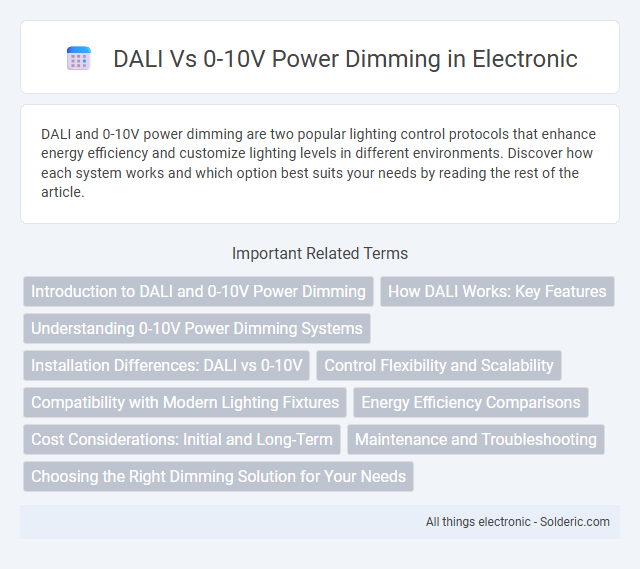DALI and 0-10V power dimming are two popular lighting control protocols that enhance energy efficiency and customize lighting levels in different environments. Discover how each system works and which option best suits your needs by reading the rest of the article.
Comparison Table
| Feature | DALI | 0-10V Power Dimming |
|---|---|---|
| Control Type | Digital Addressable Lighting Interface | Analog Voltage Control |
| Wiring | Two-wire bus (data and power) | Two-wire low-voltage signal |
| Communication | Bidirectional digital communication | Unidirectional analog voltage signal |
| Addressability | Individually addressable fixtures | No individual addressing (group control only) |
| Compatibility | Requires DALI-compatible drivers and controllers | Widely compatible with standard 0-10V dimmable drivers |
| Control Precision | High precision with 256 brightness levels | Lower precision; voltage varies from 0 to 10 Volts |
| Feedback | Supports status and diagnostic feedback | No feedback capability |
| Installation Complexity | More complex due to address programming | Simple wiring without programming |
| Cost | Higher initial investment | Lower cost solution |
Introduction to DALI and 0-10V Power Dimming
DALI (Digital Addressable Lighting Interface) is a standardized protocol enabling precise digital control and communication between lighting devices, allowing individual fixture addressability and complex scene settings. The 0-10V power dimming system uses an analog voltage signal ranging from 0 to 10 volts to adjust light intensity, offering a simpler and widely compatible dimming solution for fluorescent and LED drivers. DALI supports bidirectional communication and advanced automation, whereas 0-10V dimming provides basic, continuous dimming without feedback capabilities.
How DALI Works: Key Features
DALI (Digital Addressable Lighting Interface) operates through a two-wire digital communication protocol allowing individual addressability and control of lighting fixtures. It enables precise dimming levels, scene setting, and real-time status feedback, enhancing energy efficiency and customization. Key features include bidirectional communication, easy commissioning, and compatibility with various lighting devices, offering superior flexibility compared to traditional 0-10V analog dimming systems.
Understanding 0-10V Power Dimming Systems
0-10V power dimming systems control light intensity by varying a low-voltage DC signal between 0 and 10 volts, allowing dimmers to adjust lighting levels smoothly. This method is simple, widely compatible with many fixtures, and operates by directly influencing the ballast or driver of fluorescent and LED lights. Understanding the signal range helps optimize energy savings and achieve precise lighting control tailored to commercial or residential environments.
Installation Differences: DALI vs 0-10V
DALI (Digital Addressable Lighting Interface) systems require digital wiring with two data lines, enabling individual control and feedback for each fixture, while 0-10V dimming uses simple analog low-voltage control wires, typically just two conductors, for proportional dimming signals. Installation of DALI involves more complex programming and setup but offers scalability and advanced features, whereas 0-10V is easier to install with straightforward wiring but lacks addressability and diagnostics. Your choice affects installation time, cost, and future expandability of the lighting control system.
Control Flexibility and Scalability
DALI offers superior control flexibility compared to 0-10V power dimming by enabling individual addressable control of multiple fixtures within a network, allowing for advanced lighting scenes and automation. 0-10V dimming provides simpler, analog control limited to linear dimming and grouping but lacks scalability for complex installations. Your lighting system benefits from DALI's scalability, accommodating future expansion with minimal rewiring and enhanced integration into smart building controls.
Compatibility with Modern Lighting Fixtures
DALI (Digital Addressable Lighting Interface) offers superior compatibility with modern lighting fixtures, providing precise digital control and allowing for individual addressing of luminaires in complex smart building systems. Unlike the 0-10V power dimming method, which relies on analog voltage signals and may face limitations with LED driver compatibility, DALI supports bidirectional communication and integration with energy management systems. This makes DALI the preferred choice for advanced, scalable lighting installations that require flexibility and detailed fixture monitoring.
Energy Efficiency Comparisons
DALI (Digital Addressable Lighting Interface) power dimming offers superior energy efficiency compared to traditional 0-10V dimming by enabling precise, individually addressable control of lighting fixtures, which reduces unnecessary power consumption. 0-10V dimming operates through an analog signal that provides less granularity, often leading to less optimized energy savings due to uniform dimming across multiple fixtures. Implementing DALI systems can achieve energy savings of up to 30% more than 0-10V setups by integrating advanced scheduling, daylight harvesting, and occupancy sensing capabilities.
Cost Considerations: Initial and Long-Term
DALI systems generally have higher initial costs due to advanced digital components and programming requirements, while 0-10V dimming offers a more affordable upfront investment with simpler installation. Over time, DALI's enhanced energy efficiency and scalability reduce operational expenses, making it more cost-effective for large or complex lighting setups. Your choice depends on balancing initial budget constraints against long-term energy savings and maintenance benefits.
Maintenance and Troubleshooting
DALI (Digital Addressable Lighting Interface) offers advanced maintenance and troubleshooting capabilities by enabling individual fixture communication and real-time diagnostics, significantly reducing downtime and service costs. In contrast, 0-10V power dimming relies on analog signals without feedback, making fault detection and pinpointing issues more time-consuming and less precise. Choosing DALI can enhance your ability to quickly identify and resolve lighting system problems, ensuring smoother operation and easier upkeep.
Choosing the Right Dimming Solution for Your Needs
Choosing the right dimming solution depends on your lighting control requirements and system complexity. DALI offers advanced, addressable dimming with individual fixture control and integration into building automation systems, ideal for large-scale or smart lighting projects. Your selection may favor 0-10V dimming for simpler installations with cost-sensitive needs, providing straightforward analog control compatible with many LED drivers.
DALI vs 0-10V Power Dimming Infographic

 solderic.com
solderic.com